Return of the Cicadas is a documentary about the return of the Brood X periodical cicadas, by producer Samuel Orr. It is worth watching for for folks in the Brood II area so they know what to expect.
Take a look:
Dedicated to cicadas, the most amazing insects in the world.
Return of the Cicadas is a documentary about the return of the Brood X periodical cicadas, by producer Samuel Orr. It is worth watching for for folks in the Brood II area so they know what to expect.
Take a look:
Update:
I received my Cicada Princess clay cicada that was an actual actor/actress in the movie:
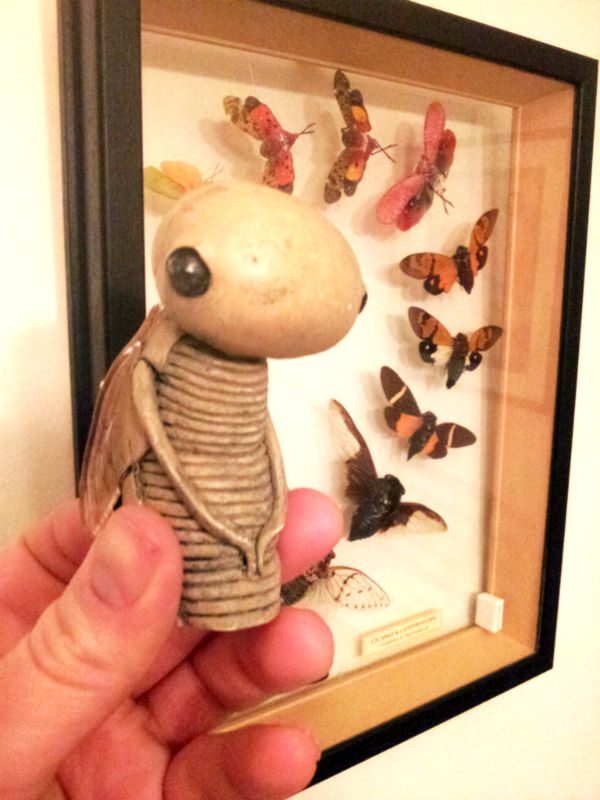
And here’s the URL to the movie: www.cicadaprincess.com
Here’s some news for cicada fanatics: the movie Cicada Princess has officially wrapped post production and was and successfully submitted it for consideration to the Sundance Film Festival. Read more about it. Congratulations to film maker Mauricio Baiocchi.
The Cicada Princess is a stop-motion animated movie featuring anthropomorphic cicadas. It was funded via Kickstarter contributions. Visit the Cicada Princess website. Here at Cicada Mania, we’re interested in both real and fictional cicadas.
Yesterday I visited my family’s house in Metuchen, New Jersey. I looked in the backyard and found loads of cicada holes — a hole every 6″ to 12″. I was also clear that animals, like squirrels and raccoons, had been digging at many of the holes. Today I got a spade and gently dug around one of the holes. About 3″ down I found a Magicicada cassini nymph, about 1 inch in length, legs wiggling slowly, red eyes.
Here’s the hole:
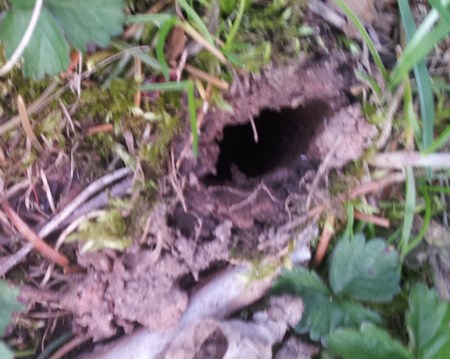
Here is the nymph:
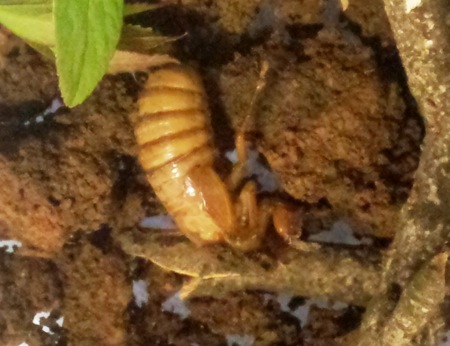
It’s clear that the cicadas are ready to emerge, and are just waiting for the temperatures to get a little warmer (to warm their bodies to around 64 degrees F/18º C). Today reached 72 degrees F. It will reach 77 F on Friday, and some will likely emerge. Saturday temperatures will be back down to 39 F. These cicadas will likely be confused for a little while.
More holes, many of which were widened by predators looking for a cicada snack!
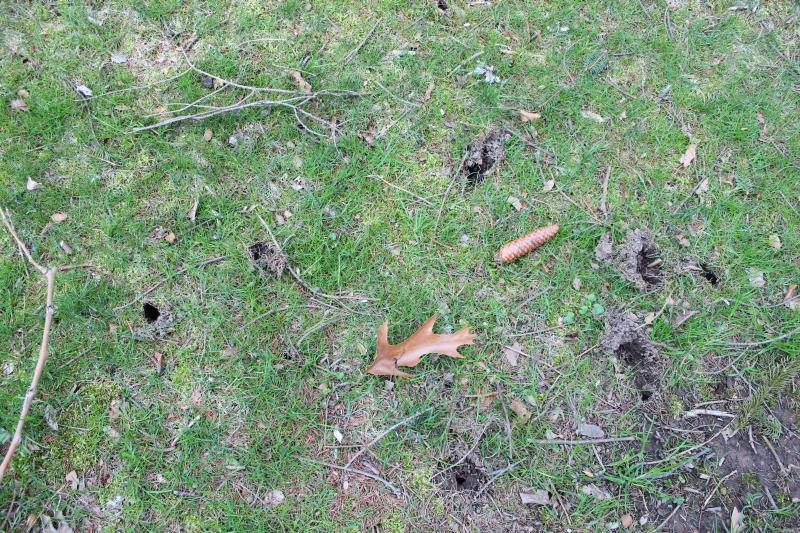
Also visit: updates on the emergence.
Gene Kritsky is one of the leading periodical cicada researchers. He’s asked that we help with his research regarding temperature and cicada emergence. He needs to know the date that cicadas first emerge, and then the date when they appear in large numbers in a given locality. To contact Gene with your findings, email him at cdarwin@aol.com.
Here are the details:
I wanted to alert you to a paper that I published with Roy after Brood XIV. I had placed sensors at cicada depths in Roy’s backyard, and also hung others in the area trees. We recorded the temperatures at 10 minute intervals at all the locations. I was trying to find a weather model to predict soil temperatures without using probes. This would be cheaper for people wanting to monitor an impending emergence. This research is based on what potato farmers do to track the growth of their crop.
We found that the average of the running three day and two day mean temperatures was a good predictor of soil temps.
The formula along with the extended forecast can be used to forecast soil temperatures. Once we get the 64º F soil temps and a nice rain we got emergences. I am hoping to test this model again this year, which in part is why I emailing you. What I need to know is the date that cicadas first emerge, and then the date when they appear in large numbers in a given locality. I will then use weather data to check the soil model. Can you ask readers to send me that info? Many thanks.
You can find more details on the model at:
http://inside.msj.edu/academics/faculty/kritskg/cicada/Site/Estimating_soil_temperature.html
An easier way of getting to the details is to go to www.msj.edu/cicada and click on estimating soil temperatures. That site will also link them to John’s mapping page, activities for kids, etc.
Thank you for your help.
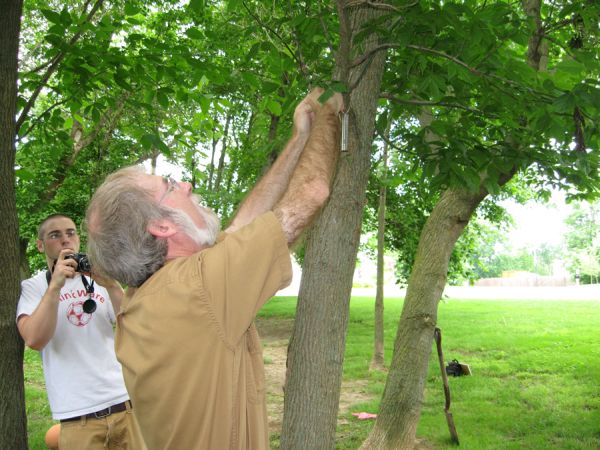
More info about Gene Kritsky:
My Goals and Objectives for the Brood II Emergence:
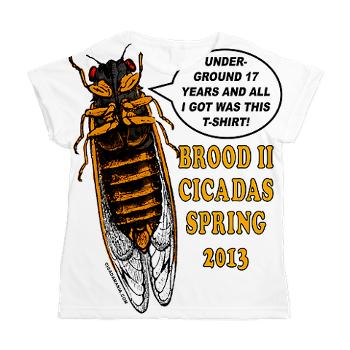
Chances are you might see me during the emergence. I’m told I look like “Lucius Malfoy”.
Updated as of 2/20/2014.
Martin Kolner sent us photos of two beautiful cicadas from Sapa Vietnam.
The first one belongs to the genus Angamiana, and I think it is an Angamiana floridula might be a Proretineta vermacula (Chou& Yao, 1985), according to David Emery.
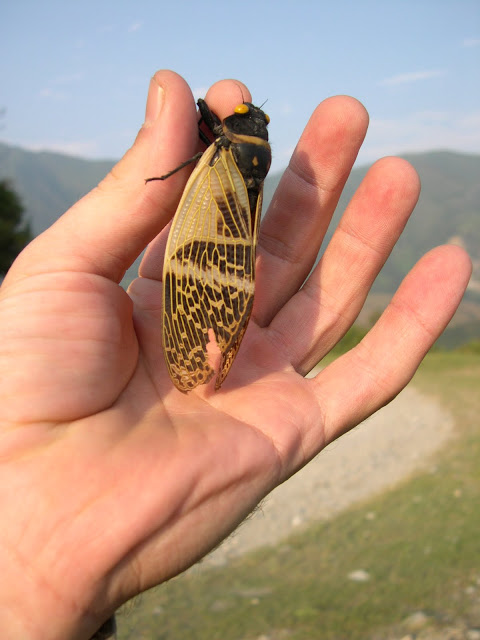
The second cicada belongs to the genus Tosena.

According to David, the Tosena is “likely to be T.fasciata (melanoptera does not have orange anywhere), even though the dorsal markings are pretty bleached”.
John Cooley of Cicadas @ UCONN (formerly Magicicada.org) kindly provided us with an updated version of the Brood II map. The old map was circa 1907. Click the image below for a BIG version:
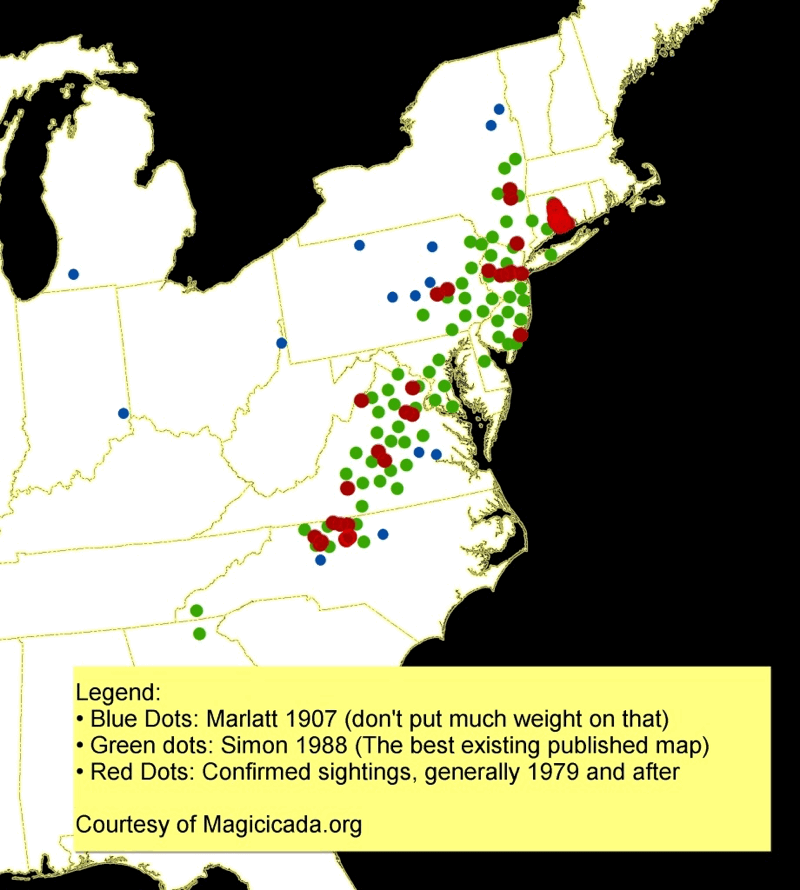
If you’re very interested in recording data for the Brood II emergence, John posted a handy PDF and Excel sheet on the Entomology-Cicadidae Yahoo Group.
Download the PDF here: www.cicadamania.com/downloads/diversity-05-00166.pdf.
We are excited to announce the availability of a document by Allen F. Sanborn and Polly K. Phillips titled Biogeography of the Cicadas (Hemiptera: Cicadidae) of North America, North of Mexico. This document features distribution maps for North American cicada species! This document is an excellent companion to The Cicadas (Hemiptera: Cicadoidea: Cicadidae) of North America North of Mexico by Allen F. Sanborn and Maxine S. Heath (link to that book).
Abstract: We describe and illustrate the biogeography of the cicadas inhabiting continental North America, north of Mexico. Species distributions were determined through our collecting efforts as well as label data from more than 110 institutional collections. The status of subspecies is discussed with respect to their distributions. As we have shown over limited geographic areas, the distribution of individual species is related to the habitat in which they are found. We discuss the biogeography of the genera with respect to their phylogenetic relationships. California is the state with the greatest alpha diversity (89 species, 46.6% of taxa) and unique species (35 species, 18.3% of taxa). Texas, Arizona, Colorado and Utah are the states with the next greatest alpha diversity with Texas, Arizona and Utah being next for unique species diversity. Maine, New Hampshire and Rhode Island are the states with the least amount of cicada diversity. Diversity is greatest in states and areas where there is a diversity of plant communities and habitats within these communities. Mountainous terrain also coincides with increases in diversity. Several regions of the focus area require additional collection efforts to fill in the distributions of several species.
Keywords: cicada; distribution; Diceroprocta; Tibicen; Okanagana; Okanagodes; Cacama; Magicicada; Platypedia; Cicadetta
An example of a map from the document:

Are you preparing for the 2013 invasion of the Brood II Magicicada? If so, what type of cicada prepper are you?
If you’re visiting Cicada Mania, you’re probably trying to figure out when and where the Brood II cicadas will emerge. We have a page for that.
Once the cicadas arrive you’re also going to report them to Cicadas @ UCONN (formerly Magicicada.org), right? You’re also going to upload your photos and video to Facebook, Flickr, Twitter, YouTube, Vimeo, Pinterest, and Instagram, right? You’re going to tag your photos & video with appropriate tags like #BroodII, #Magicicada, and #17YearCicada as well.
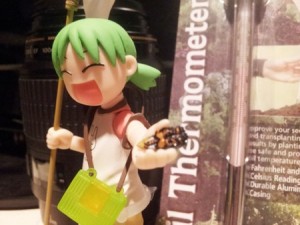
Kids will probably enjoy a cicada emergence more than any one group of people. Kids will want to learn, capture, collect, observe, photograph, draw, and write about cicadas.
If you want to learn about cicadas, there are many cicada websites, including Cicada Mania. There are also many books to read; ask your local library to obtain a few of them.
Capturing periodical cicadas is easy. Unlike other insects, these cicadas are slow and easy to grab when they’re on the ground on low on a tree. You can use a butterfly net if you want to catch one in flight. At night, when they first emerge, they are especially easy to catch. You can use a flashlight to spot them coming out of the ground, and shedding their skins on tree branches.
A portable butterfly pavilion is a great place to temporarily keep and observe cicadas. It’s a lot better than a coffee can with holes punched in the lid. Another good option is to use an old aquarium and turn it into a terrarium filled with natural objects, like tree branches. You can also wrap a tree branch with netting and place the cicadas inside that, and observe then in their natural habitat.
It’s good to have a magnifying glass or a camera with a zoom feature so you can observe the cicadas up close. If you have a camera, make sure you take plenty of photos and videos so you have something to remember about the cicadas.
Preparation list:
Do you consider yourself a citizen scientist or amateur cicada researcher?
Prior to the emergence cicada researchers will monitor the temperature of the soil, using a ground thermometer, or a cicada tracker. They will also monitor the ground for dime-sized holes and cicada chimneys.
Each night the cicada researcher will check the ground at the foot of trees, waiting for the first emerging nymphs.
Once the nymphs start to emerge, the cicada researcher will record the location, take photos, video, and take notes on the number of cicadas observed. The researcher will also likely keep some samples of the cicada population.
After about a week, the male cicadas will be ready to sing. At this point, the researcher will record the cicada’s song with an audio recording device.
If you’re interested in collecting specimens, Bioquip has plenty of pinning and mounting, insect storage and netting supplies.
Massachusettes Cicadas has a good article on pinning cicadas.
Preparation list:
My best tip for photographers and videographers is practice shooting at night. Most Magicicadas will emerge at night, and you don’t want to miss their emergence and amazing transformation from nymph to adult!
My trick is to point a flashlight beam at the cicada — that way the camera will see the cicada and you won’t spend a lot of time getting the camera to focus and flash in the dark.
Don’t forget your best macro lens as well, to get great up-close shots.
Preparation list:
Yes, a lot of people eat cicadas! People add them to stews, chili, or just fry them up with spices! People even add them sweets like cookies and ice cream! I like to call them “shrimp of the dirt”.
Cicadas, like all insects, are arthropods — just like lobsters, shrimp and crabs — so you might be able to prepare them using similar spices. Buttered, spicy cicada — nummers!
My tips: 1) You do not want to eat them if your neighbor has sprayed them with insecticide first; 2) I hear they’re tastiest when they’re still recently emerged and white (teneral); 3) Consult your doctor before eating any creature that has lived underground for 17 years.
I, personally, haven’t tried to eat a cicada. I’m not squeamish; I just like them too much to eat one, and I suffer from arthropod allergies (I get gout when I eat crustaceans), so I avoid trying cicadas.
More info on eating cicadas, including recipes.
Preparation list:

I can sympathize with gardeners who are afraid that cicadas will damage or kill their plants. The good news is cicadas are not like true locusts. True locusts (which are actually a form of grasshopper) will strip plants of all leaves, flowers, and fruit. Cicadas only damage trees when they lay their eggs in branches. Typically a few of the weaker branches of a tree will die or weaken. The leaves turn brown, which is called flagging.
Cicadas are interested in trees. They can’t kill a large elm, maple, or oak. Where they can cause damage is to weaker ornamental flowering and fruit trees.
I’ve never personally experienced catastrophic cicada tree damage, but I’ve also never owned a flowering, miniature pear tree.
Preparation list:
I don’t recommend pesticides for three reasons: 1) collateral damage to other species of insects like honey bees, 2) I’m tired of hearing about pets that die from eating cicadas tainted with pesticides, and 3) I think cicadas are awesome, and I want to see them survive.
Be prepared to have to clean up dead cicadas in your yard. Depending on the number of cicadas in your neighborhood, you might need to clean them up with rakes and shovels, buckets, and wheelbarrows. They definitely stink when they start to rot, so you might want to bury them in a large hole, and cover the corpses with lime. I’ve heard of people composting their bodies as well.
Preparation list:
What is crowdsourcing? Here is what the Wikipedia says:
Crowdsourcing is the practice of obtaining needed services, ideas, or content by soliciting contributions from a large group of people, and especially from an online community, rather than from traditional employees or suppliers. Often used to subdivide tedious work or to fund-raise startup companies and charities, this process can occur both online and offline.
There are two prominent cicada crowdsourcing efforts you can take part in!
First, there is the Cicada Tracker project:
The group Radiolab is hoping you’ll build what they call a cicada tracker. A cicada tracker will measure the temperature of the soil and report that back to Radiolab, to help estimate the arrival of the cicadas. Here is a short video about the project:
The Cicadas Are Coming! from Radiolab on Vimeo.
Throughout April there will be events where you can get to together with other cicada enthusiasts, and build cicada trackers. See their website for more details.
Second, there is Cicadas @ UCONN (formerly Magicicada.org).
Cicadas @ UCONN (formerly Magicicada.org) is a website where you can report and map cicada emergences in your area. I strongly suggest that everyone visits that site to report their cicada sightings. Your reports will be used to build new and better maps of the periodical cicada populations in the U.S.A.
When you visit their site, look for this icon, click it and enter your report:
Information needed for the report include the location (GPS coordinates, or simple street address), and what you observed: was it a nymph or adult, how many were there, etc. I think they’ll even have a Google maps interface to help you locate your sighting.